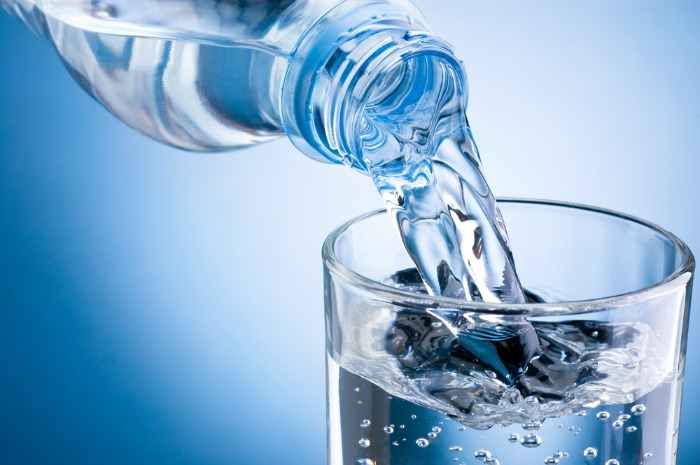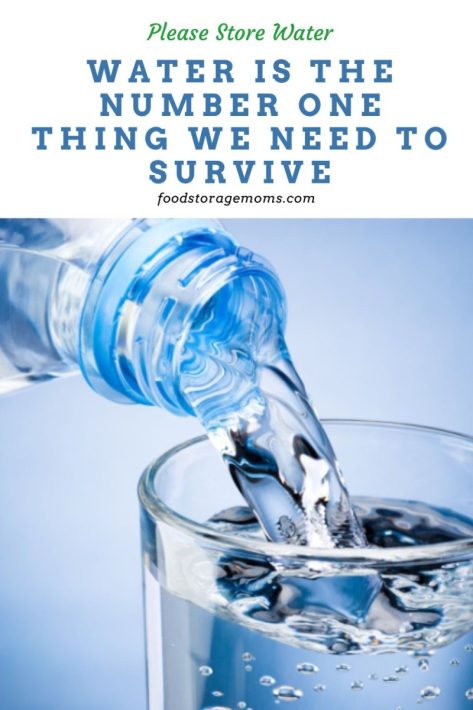
As you may know, water is the first thing we need to survive. You can live three minutes without air, three hours without shelter (very hot or cold), three days without water, and three weeks without food.
I share those tidbits with you to explain why we need to store water. Of course, we need air, shelter, and food, but today, we are talking about water for survival. Here’s the deal: Sometimes, we need a friendly reminder to store water. Remember, I’m agrandmother, mother, sister and aunt watching out for the safety of my family.
So, if you feel so inclined, get a yellow sticky to remind you to get some extra water or fill the water storage containers you may have that need filling. Don’t forget to use a lead-free hose to fill them. A lead-free hose is the one you use with a trailer camper, etc.

Flint Michigan Water
Speaking of lead, this reminds me about the lead poisoning that happened in Flint, Michigan. This situation disturbed me because we assume our city or county is testing the water we consume. We take for granted that the water is okay to drink and cook with when we turn the kitchen tap on. You may want to think again, my friends.
The families in Michigan were given drinks, soup, juice, and many other things for their kids and other family members. The Flint water was found to be contaminated with lead, which is one of the most dangerous things in our environment that our bodies can ingest.
Here is a link to the news article I read: CNN Report on Flint, Michigan. There are others, but this one lays out the lead issues. Let’s hope the people in Flint, Michigan, did not store that water in water storage containers for survival. Think about it; that scares me.
Flint, Michigan, Pediatrician
Thankfully, a local pediatrician started questioning why so many of the children visiting the clinic had similar symptoms, including rare rashes and hair loss. She went to the authorities after she had blood tests performed on the children’s blood.
This story makes me think twice about the city water I am storing; what about you? Luckily, I have a Big Berkey water purifier. Today’s post is to make people worldwide aware of the water we are using out of our local city/county water taps.
I lived in Farmington, Utah, back in 1983 for several years, and our faucets and shower heads had yellow water. I took a glass into the city and asked the city leader about the water supply at the time and why our water was yellow.
He said the water was fine. I think not. That was about 40 years ago, and I immediately stopped using the water and ordered spring water to be delivered to our home in those five-gallon containers.
Now, I want to mention is that our white tiled shower with white grout turned yellow where the shower water hit the tile. You can’t tell me that is normal.
Reverse Osmosis
I now use a reverse osmosis water treatment system in my kitchen. This system is much cheaper than the purchased water containers, and the water is better and safer to consume.
I remember a good friend’s wife died from cancer in Farmington, Utah, in 1999. I talked to the husband, Dave A., and he said a high number of cancer cases were showing up in his neighborhood.
He and I talked again after I spoke to some of my neighbors in the north end of Farmington, Utah. We started counting the homes, and it seemed like every third home had someone with some form of cancer. He took it to a local TV station. They claimed nothing was wrong. I’m afraid I have to disagree.
We are not physicians or someone in the government, but there has to be something in the ground, water, or whatever, to make it turn yellow. It would be interesting to see the number of cancer patients in that area now. Maybe it’s something else besides the water, but at this stage, who knows?
Water To Survive:
The CDC Emergency Preparedness and Response website recommends storing one gallon of water per person daily to survive. I quote from the CDC:
“Prepare an Emergency Water Supply
- Store at least 1 gallon of water daily for each person and each pet. It would be best to consider storing more water than this amount for hot climates, pregnant women, and sick people.
- Store at least a 3-day water supply for each person and each pet (try to store a 2-week supply if possible).
- Observe the expiration date for store-bought water; replace other stored water every six months.
- Store a bottle of unscented liquid household chlorine bleach to disinfect your water for general cleaning and sanitizing.
Note: Caffeinated drinks and alcohol dehydrate the body, which increases the need for drinking water.”
I Recommend 4 Gallons To Survive:
I recommend 4 gallons per person daily and will explain why I feel a significant amount is needed. I suggest 4 gallons of water to be fully hydrated, cook, brush my teeth, and wash my underwear daily. I wouldn’t be washing jeans or heavy items, but I need clean underwear.
Also, I am fearful that others are not as prepared as I am; I cannot turn away a small child who is thirsty or hungry. Please think about it. I recommend a minimum of two weeks’ worth of water for each family member.
Yes, I said two weeks, minimum. I prefer 30-60 days, but I have to be realistic. I understand that space and budgets are critical issues. Of course, if you live near a river that doesn’t get diverted after a disaster, you can hopefully filter the water or purify it.
Start today with the amount of water you can store for a day. Then move on to two or three days; eventually, you will have 30 days’ worth of water stored. If you have the room, store more water.
Swimming Pools Are Not A Good Option
If you have a swimming pool, that is not the best option for water. The reason is that the water can become contaminated quickly if you have lost power because the water has not been circulating or filtered. Without electricity, algae will overtake your pool.
The water could be dangerous to consume. I hesitate to recommend using a filter with the pool water because of possible air contamination. I prefer not to count on the pool water. Also, if we have an earthquake, that pool may become non-existent.
Water Storage Containers (filled or unfilled):
- WaterBricks–WaterBrick stackable Water and Food Storage Container, 3.5 gals of Liquid, 27 lb of Dry Food Products, Blue
These would be perfect to figure one Waterbrick (even though it’s only 3.5 gallons) per person per day. Easy peasy. They are stackable and easy to slip under beds if your box spring is high enough off the ground.
- Water Preserver–Water Preserver Concentrate
I prefer this over bleach because I only have to rotate my water every five years instead of the recommended six months for bleach.
- Blue Cans: The 24 cans in a case are the size of a soda can and are packed in a sturdy cardboard box. Each box of 24 cans equals 2.25 gallons. These fit perfectly under a bed or in a closet. The water is the best-tasting water in the world, literally. I buy one or two cases monthly and stack them in my closet. These would be great for college students, single moms, and families because we can set and forget these cases for 50 years. Sweet! Thanks to a fantastic reader, the cheapest place I have found is Brownells to buy these cases.
- 55-gallon water barrels – You can get these barrels with a pump at Walmart or your local emergency preparedness stores. They usually have the pumps you can buy with the barrels close to where the blue barrels are stacked. These are relatively inexpensive and more challenging to use based on how you access the water. You will need a pump, and please place some two-by-fours under the barrels so they do not sit directly on any concrete or soil. This will stop any chemicals in the concrete or soil from leaching into the barrels.
- Lead-free hose-Camco
Please use a lead-free hose when filling your water storage containers. Let’s be safe; hopefully, your city water is lead-free.
Ways To Boil Water:
Now, if you do not have a water filter or purifier, I suggest you find some way to boil the water you have stored if you need to boil it. The lead situation above could not be boiled to remove the lead. Boiling water produces more lead as the water evaporates through the boiling process. Check this out: CDC Lead and Drinking Water. I quote: “Heating or boiling your water will not remove lead. Because some water evaporates during the boiling process, the lead concentration can increase slightly as the water is boiled.” End of quote.
I want you to picture your neighborhood and think of ways to get together after a minor disaster. If you and your neighbors are without electricity for a few days, think how nice it would be to sip a cup of coffee, tea, or hot chocolate together.
Butane Stove: Butane 1-Burner Stove I have purchased one for each of my daughters so they have one way to boil water in the event of an unforeseen emergency.
Butane Fuel: Butane Fuel This fuel will boil water or cook many meals. I see it this way, I only need to use the butane stove and fuel once a day to have a hot meal or boil some water.
Kelley Kettle: Kelly Kettle Large Stainless Steel Base Camp Basic Kit I love the Kelly Kettle for two reasons. First, you can use kindling or pine cones to fire and boil water outside. If you have a match, you are good to go. Firestarters are a bonus. You can make soup and hot chocolate with one of these babies!
Final Word
I hope today’s post makes you think outside the box to be prepared for the unexpected. You can survive any disaster if you have a plan. I hope you have purchased my book in paperback so you are ready for any emergency “Prepare Your Family For Survival.” May God bless this world, Linda
Copyright Images: Pouring Water in A Glass AdobeStock_253849562 By Hyrma
The post Water Is The Number One Thing We Need To Survive appeared first on Food Storage Moms.
from Food Storage Moms
No comments:
Post a Comment